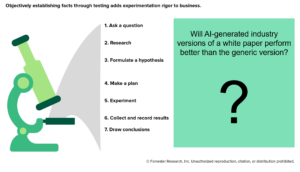What Ninth-Grade Biology Has In Common With Optimizing B2B Content
Late last year, I interviewed content industry experts for a report on the future of B2B content. We talked about the challenging state of B2B content operations, the impact of new technology, and the call for greater personalization. Forrester’s research indicates that 77% of marketers know that audiences expect a personalized experience, yet only a minority focus on personalizing actual content assets. Most marketers test the performance of one version of an ad banner or landing page against another, for example, and then activate the winning version. But given ever-growing audience expectations for tailor-made content and the availability of technology to support customization, it’s time that we bring personalization and testing beyond demand programs to the content-asset level.
To better understand marketing experimentation and its potential impact on content, I spoke with vendors, practitioners, and industry experts. All agreed that there’s great opportunity to innovate, test, and scale content personalization, especially given the potential offered by generative AI. I also read the book “Experimentation Works” by Stefan H. Thomke, in which he points out that “ […] no innovation can exist without first being an idea that is subsequently shaped through experimentation.”
I cover the topic of experimentation in my new report: Deliver The Content Relevancy That Audiences Crave Through Experimentation. In it, I highlight the use of the classic scientific method in business experimentation. Business experimentation relies on the same process I remember using in ninth-grade biology. I fondly recall impressing my teacher with a few simple conclusions from an experiment designed to prove the hypothesis that plant growth varies depending upon the type of light-source exposure. I remember running the test procedure: I placed identical plants in different environments with varying light sources, measured and compared their growth over a specified period, and then reported my findings.
So what does content experimentation look like? Consider a scenario in which the question posed is whether customizing a generic white paper with industry-specific content will improve engagement results (see image). First, the research you might conduct might include evaluating the differences in industry audience information needs and preferences. Based on the research, you’d craft a hypothesis, which could be, “AI-generated financial services and life-sciences white-paper versions will perform at least 25% better than a generic version.” Next, you’d come up with a way to compare the performance results of “test” and “control” asset versions, distributed using the same method to ensure scientific rigor. In the final step, you’d collect the results and draw conclusions that fuel next steps. In this example, you might find that the experiment validates that audience engagement is optimal only when the industry version is informed with specific types of vertical insights — success isn’t a sure thing for every industry. As such, the experiment would have provided the additional knowledge needed to scale this particular content innovation approach methodically and successfully.

Are you considering new personalization initiatives, such as customizing content assets based on specific audience-segment needs? If you’re a Forrester client, please reach out if you need help. If you’re already engaged in content personalization, I’d love to hear about your experiences.
